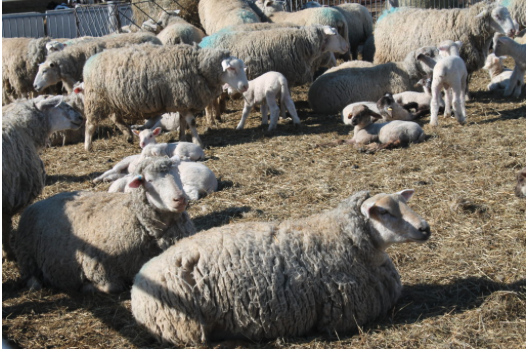Current Temperature
-6.3°C
RDAR project has smart handheld device for automatic blood analysis
Posted on August 23, 2022 by Ryan Dahlman Photo courtesy RDAR
Photo courtesy RDARContributed
As an Alberta-based discovery and tool to support Canadian lamb production, and a novel product for the international market, a company is
optimistic of the tremendous potential this device and the processes that go into it will hold for the livestock industry.
How will this research help increase the competitiveness and profitability of Alberta’s agriculture industry?
With the development of a smart, handheld device for automatic blood analysis, this innovative technology can provide a more clear prediction of sheep pregnancy and litter size. Current livestock diagnostic methods generally involve expensive laboratory equipment run by specialized personnel. The creation of a point of care – pregnancy litter size (PoC PLS) tool will allow targeted nutrition management
of ewes to enhance lamb survivability and ultimately improve flock profitability & competitiveness.
•This device template would significantly decrease the cost of similar endeavors with other livestock.
•For the sheep industry alone, improved lamb survivability and reduced ewe pregnancy-related illness and dystocia is anticipated.
•This technology allows for cost-effective and decentralized diagnosis that is made accessible to remote or disadvantaged populations while reducing the time between sampling and treatment decisions
•reduced pregnancy related diseases and improved health and performance of live lambs born to properly fed ewes will be realized.
•Management advantages in saved feed and ewe maintenance costs and improved genetic selection will be
•had through the ability of flock managers to both identify culls and/or re-breed open ewes for other markets.
•Assuming 80% test accuracy and 50% adoption rate, this device could net a return of up to approximately $50 000/yr for Canadian Sheep owners
Why did RDAR invest in this research project?
RDAR has funded this Alberta-based discovery & tool to support Canadian lamb production. From this project we are optimistic of the tremendous potential this device and the processes that go into it will hold for the livestock industry. For the sheep industry alone, improved lamb survivability and reduced ewe pregnancy-related illness and dystocia is anticipated.
RDAR selected to fund this critical research because developments from this project will not only decrease costs of similar diagnostic endeavors with the sheep species but other livestock species as well.
Discussions with both large feedlot & cow/calf producers and large pharmaceutical companies indicate applicability to other species and other uses also exist. There is immediate need in the AB feedlot industry to detect pregnant feeder heifers for abortion, thus saving drug use & associated costs.
Lakeland College has a focus on reproductive and production efficiency research. This project will support the success of Alberta’s agriculture industry by the creation and use of beneficial new technology, tools, protocols and outreach that improve pregnancy and reproductive outcomes for our livestock industry.
These potential uses of this device will benefit the Canadian business economy and add value to companies poised to take advantage of the device and its’ processes.
What are the short-term research objectives for this project?
The central objective is to create an accurate, accessible and affordable device for independent, real time pen-side detection of ewe pregnancy and litter size (PLS) for those who either cannot access qualified ultrasound technicians and/or are unable to justify the costs due to their location or flock size.
This project proposes to develop a single handheld point-of-care device capable of accurately detecting both sheep pregnancy and estimating litter size at ~50 days into pregnancy. This device will be easy to use and perform chute-side diagnosis for flock managers on farm.
What are the long-term research outcomes for this project?
Outcomes related to both advancement of industry knowledge and advancement of technology readiness levels (TRL) will be pursued. Additionally, through the partnerships with industry there will be outreach events in at least 2-3 provinces to disseminate the knowledge gained and/or demonstrate the protocols for pregnancy and litter size detection.
Face-to-face meetings and/or virtual events will be organized to update industry on this novel technology. Print and radio outreach will take place in 4-6 different media outlets. Furthermore, strong industry support will enable our team to gather (through industry group surveys) valuable data on gestating and lactating ewe nutrition and health protocols plus lamb rearing systems for benchmarking purposes as we assess potential endusers of this tool on farm.
How will this project’s research knowledge be transferred and shared with producers?
•Traditional print outreach will be conducted using popular press like the national sheep magazine, provincial organization newsletters and
•regional radio spots or newspaper articles.
•The project team will organize a ewe reproductive tools mini conference/webinar through both the Technology Access Centre for Livestock Production (TACLP) at Olds College and the Lakeland College Centre for Agriculture Technology (CAT) Livestock Reproductive Technology Laboratory to invite qualified speakers on nutrition, ultrasound, laboratory diagnostic tools and our hand held detection tool to be showcased and demonstrated
•Collection of industry data for benchmarking purposes as it relates to gestating and lactating ewe nutrition and health protocols.
•At least one peer reviewed scientific journal publication submission, attendance at scientific conferences, producer meetings and
•presentations either or both oral & poster will be pursued to share the research findings with the academic community and industry at the end of the project.
Leave a Reply
You must be logged in to post a comment.

